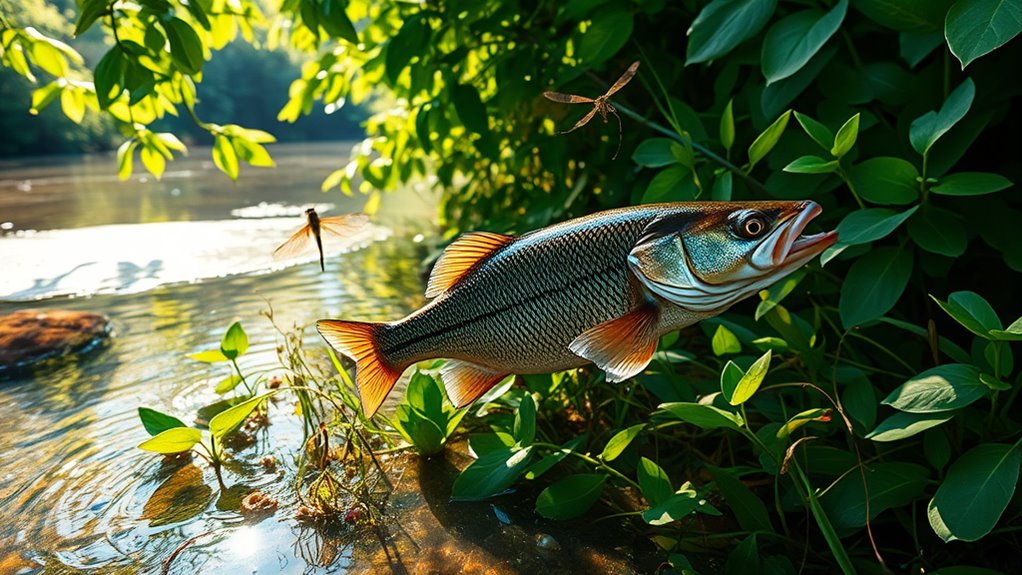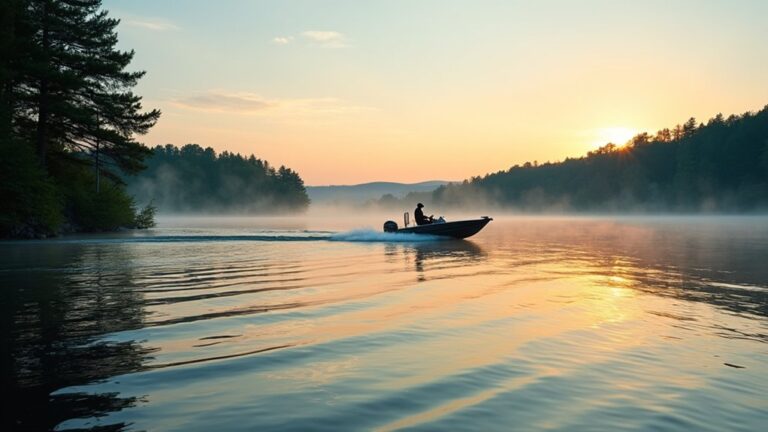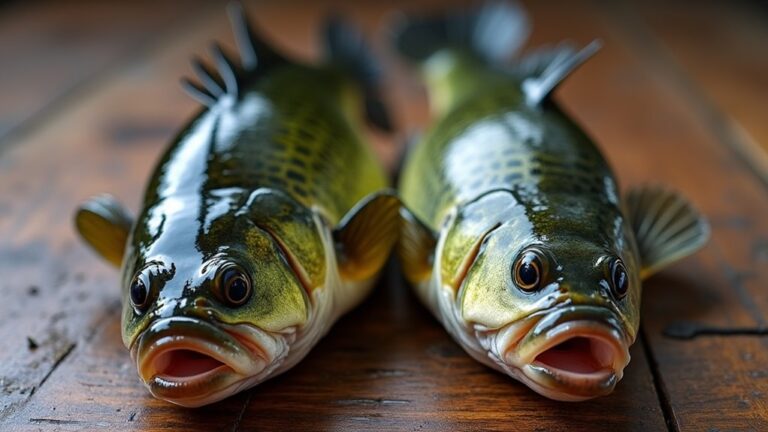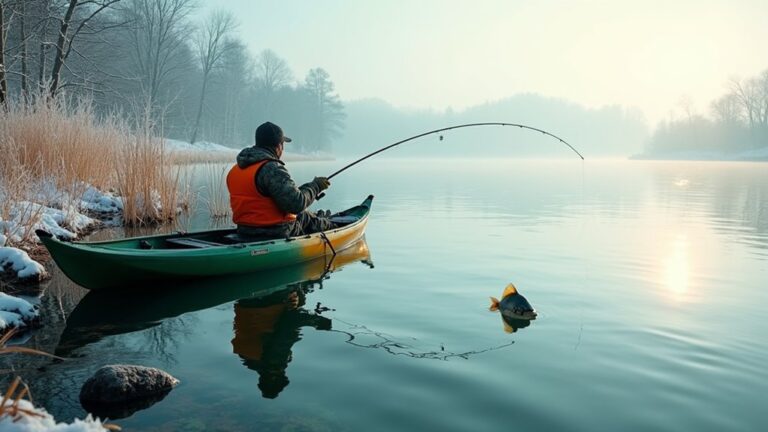Invasive species pose serious threats to native bass populations in North American waters. You'll find that zebra mussels, round gobies, and sea lampreys directly impact bass through multiple channels – reducing their food sources, competing for habitat, and causing direct mortality. These invaders can trigger population declines of up to 35% in affected areas. While the situation is concerning, various management strategies and control measures offer hope for protecting these valuable sportfish species.
Understanding Native Bass Ecosystems
While native bass species have evolved to thrive in balanced aquatic environments, their survival depends on complex ecological relationships within their habitats.
You'll find that both largemouth and smallmouth bass populations rely on intricate food webs that support their growth and reproduction. These native fish species need diverse prey options and pristine spawning grounds to maintain healthy populations.
However, the ecological impacts of invasive species have begun disrupting these natural systems, particularly in the Great Lakes region.
When habitat degradation occurs due to invasive plants and animals, it threatens the delicate balance that bass populations require. Understanding these relationships is essential because changes to any part of the ecosystem – from water clarity to prey availability – can greatly affect bass survival rates and reproductive success. Additionally, optimal fishing conditions are crucial for sustaining healthy bass populations in the face of invasive species.
Key Invasive Species Threatening Bass
Several aggressive invasive species have emerged as major threats to native bass populations across North American waterways.
You'll find that zebra and quagga mussels have dramatically reduced plankton availability in freshwater ecosystems, cutting off essential food sources that bass need to thrive.
The round goby poses another serious challenge, as it directly competes with bass for both food and habitat resources.
Sea lamprey, a parasitic invader, attacks bass directly, causing mortality and population decline.
Even invasive plants play a destructive role by disrupting critical spawning and nursery areas.
These combined threats have destabilized traditional food webs, making it harder for native bass to find resources they need for growth and reproduction.
The resulting habitat competition has created a complex challenge for bass survival in affected waters.
Competition for Resources and Habitat

Because invasive species have infiltrated North American waterways, native bass now face intense competition for critical resources and habitat.
You'll find that round gobies directly compete with native bass for food resources, particularly targeting the invertebrates and smaller fish that bass need to survive.
The situation worsens when zebra and quagga mussels filter out fundamental plankton, reducing the food supply that juvenile bass depend on for growth.
You're also seeing significant habitat degradation as invasive aquatic plants disrupt crucial spawning sites and nursery areas.
These combined pressures lead to declining bass populations and reduced biodiversity.
When you examine the ecosystem changes, you'll notice that areas with prevalent invasive species show marked decreases in bass abundance and overall community health.
Predation and Population Control
The direct predation by invasive species compounds the resource competition that native bass already face.
You'll find that aggressive predators like sea lampreys and snakehead fish directly attack bass populations, causing dramatic declines in their numbers. In the Witte River, you can observe how these invasive species have nearly wiped out native fishes through their relentless predation.
When you examine the ecological interactions, you'll notice that bass populations have dropped by up to 35% in areas where invasive species have established themselves.
This population control isn't just from direct predation – it's also affecting bass survival rates and growth patterns. The combination of predatory pressure and increased competition has created a perfect storm that's fundamentally altering native bass populations in affected waterways.
Management Strategies and Solutions

Since invasive species pose an ongoing threat to native bass populations, extensive management strategies have emerged as critical solutions.
You'll find that early detection programs combined with rapid response initiatives serve as your first line of defense against new invasions. Control measures, including targeted trapping and removal efforts, help protect native bass and restore ecosystem balance.
To strengthen these efforts, habitat restoration focusing on spawning and nursery areas provides native bass with ideal conditions for reproduction and growth.
You can see the importance of adaptive fisheries management, which uses ongoing research to adjust strategies based on new findings.
Success depends on collaboration among stakeholders – from anglers to scientists to legislators – working together to develop thorough approaches that preserve native bass populations while managing invasive species effectively.
Research and Future Outlook
Recent scientific findings paint a complex picture of how invasive species affect native bass populations, with documented impacts ranging from severe population declines to unexpected adaptations.
You'll find that research reveals both negative and positive ecological interactions between native bass and non-native species. While snakeheads and Asian carp have triggered concerning 30-35% declines in bass numbers, you can observe surprising developments in places like Virginia, where bass have adapted to use these invaders as prey.
The zebra mussel's impact presents another fascinating case, as improved water clarity has actually benefited smallmouth bass growth in some areas.
Looking ahead, you'll need to monitor ongoing research carefully, as scientists continue studying these complex relationships across different freshwater ecosystems to better understand long-term impacts and develop effective management strategies.
Frequently Asked Questions
What Is the Impact of Invasive Species on Native Species?
You'll find that invasive species harm native ones by competing for food, destroying habitats, and directly preying on them. They'll disrupt natural ecosystems, reducing biodiversity and threatening the survival of local species.
What Are the Effects of Invasive Species on Native Island Species?
You'll find that invasive species devastate island natives through predation, competition, and habitat destruction. They're especially harmful because island species have evolved in isolation and lack natural defenses against new threats.
How Do Invasive Species Affect Fishing?
You'll notice reduced catch rates and smaller fish sizes as invasives compete for food and habitat. They'll disrupt local ecosystems, damage popular fishing spots, and force you to change fishing techniques and locations.
What Is an Invasive Species and How Does It Impact the Great Lakes?
An invasive species is a non-native organism that you'll find damaging local ecosystems. In the Great Lakes, they're wreaking havoc by competing for food, altering habitats, and threatening native species' survival.
Final Thoughts
You'll need to remain vigilant as invasive species continue to threaten native bass populations. By understanding the complex relationships between invasive and native species, you can better protect these valuable ecosystems. Keep supporting local conservation efforts, follow fishing regulations, and stay informed about new management strategies. Your involvement in monitoring and reporting invasive species makes a real difference in preserving native bass for future generations.




